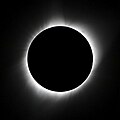| Annular eclipse | |
| Gamma | 0.3361 |
|---|---|
| Magnitude | 0.9298 |
| Maximum eclipse | |
| Duration | 492 s (8 min 12 s) |
| Coordinates | 9°24′N47°06′W / 9.4°N 47.1°W |
| Max. width of band | 277 km (172 mi) |
| Times (UTC) | |
| Greatest eclipse | 14:47:00 |
| References | |
| Saros | 141 (27 of 70) |
| Catalog # (SE5000) | 9691 |
An annular solar eclipse will occur at the Moon's ascending node of orbit on Friday, February 27, 2082, [1] with a magnitude of 0.9298. A solar eclipse occurs when the Moon passes between Earth and the Sun, thereby totally or partly obscuring the image of the Sun for a viewer on Earth. An annular solar eclipse occurs when the Moon's apparent diameter is smaller than the Sun's, blocking most of the Sun's light and causing the Sun to look like an annulus (ring). An annular eclipse appears as a partial eclipse over a region of the Earth thousands of kilometres wide. Occurring about 2.7 days before apogee (on March 2, 2082, at 8:00 UTC), the Moon's apparent diameter will be smaller. [2]
Contents
- Eclipse details
- Eclipse season
- Related eclipses
- Eclipses in 2082
- Metonic
- Tzolkinex
- Half-Saros
- Tritos
- Solar Saros 141
- Inex
- Triad
- Solar eclipses of 2080–2083
- Saros 141
- Metonic series
- Tritos series
- Inex series
- Notes
- References
The path of annularity will be visible from parts of Peru, Brazil, southeastern Suriname, French Guiana, Portugal, Spain, France, Switzerland, Italy, southern Germany, Liechtenstein, Austria, Slovenia, northern Croatia, and western Hungary. A partial solar eclipse will also be visible for parts of South America, Central America, the Caribbean, Mexico, the southeastern United States, eastern Canada, West Africa, North Africa, Greenland, and Europe.




































































































